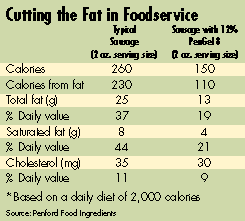
This attention is forcing Quick Service Restaurants (QSRs) to re-think their current menu choices with a stronger emphasis on nutrition. Many now are offering salads, meatless burgers, and other lower-fat items but, unfortunately, the mainstay menu items for QSRs are processed meats such as hamburgers, pork breakfast sausage and breaded chicken, all of which typically are high in fat. PenGel® fat replacer is an ingredient that mimics the attributes of fat in processed meats says its supplier, the Penford Food Ingredients Company (Englewood, Colo.).
Manufacturers making products for the QSR industry are asked to provide healthier products to either replace or augment current menu offerings. To address this need for flavorful, healthful products that consumers will continue to purchase, meat processing companies will need to remove significant portions of fat from their product formula. Typically, removal of large amounts of fat from meat products negatively impacts the attributes that drive consumer acceptance.
In the late 80s and early 90s, fat mimetic technologies used by meat processors were met with poor consumer acceptance. These technologies did not truly replace fat, as they merely allowed processors to retain more water in an attempt to mimic the juiciness of full-fat products.

It Really Tastes Like Fat
An alternative fat replacement system now is available that mimics the juiciness, texture, lubricity and visual particle definition of fat while providing significantly improved nutrition through lower fat and calorie content. Based on a modified potato starch, PenGel forms a very firm, white, starchy gel that can be used as a direct replacement for fat in meat products and as a fat mimetic in meat analog products.Typical pork breakfast sausages served at QSRs contain more than 40% fat. Hamburgers typically contain more than 20% fat. Aside from products fried in hot oil, these products contribute the largest amount of fat per meal in fast food restaurants.
By using PenGel to replace the fat trimmings portion of the meat block of pork sausage, one can reduce the finished fat content from about 43% to some 21%, an overall decrease of 52%. Total calories are reduced by the same percentage. Similar reductions in total fat are possible when using the ingredient in ground beef for hamburgers. Replacing fat trimmings with PenGel and adjusting the lean meat block may enable hamburger processors to reduce the fat in their products by as much as 50%.
Sensory evaluations of products made with and without the starch demonstrate that all of the sensory attributes driving consumer preference were retained or enhanced by the use of PenGel fat replacer. Consumers need not give up the quality they have come to expect to obtain better nutrition.
For more information:
Charlie Ferry at 303-643-1689
cferry@penx.com
www.Penford.com
Penford Food Ingredients Write in 400